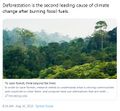File:Deforestation no.jpg: Difference between revisions
Siterunner (talk | contribs) No edit summary |
Siterunner (talk | contribs) No edit summary |
||
| Line 9: | Line 9: | ||
[https://assets.publishing.service.gov.uk/government/uploads/system/uploads/attachment_data/file/65505/6316-drivers-deforestation-report.pdf <big>'''''Deforestation, What are the Causes | [https://assets.publishing.service.gov.uk/government/uploads/system/uploads/attachment_data/file/65505/6316-drivers-deforestation-report.pdf <big>'''''Deforestation, What are the Causes -- What are the Solutions'''''</big>] | ||
'''''Afforestation and reforestation''''' | '''''Afforestation and reforestation''''' | ||
'' | ''Incentivizing countries to reduce their emissions from deforestation and forest degradation (REDD+).'' | ||
REDD+ | |||
''The REDD+ mechanism in the Paris international climate agreement aims to make forests more valuable standing than they would be cut down 1) by placing a value on the carbon they store.'' | |||
''Under REDD+ programs, countries receive results-based payments for verifiable emission reductions measured against a predetermined baseline.'' | |||
''After 10 years of working with the concept, REDD+ has indeed helped to catalyze climate-smart transformation of the forest sector. But the last decade has also shown us that we need to start broadening our thinking about forest protection and emissions reductions, because we can’t save forests if all we think about is saving trees.'' | ''After 10 years of working with the concept, REDD+ has indeed helped to catalyze climate-smart transformation of the forest sector. But the last decade has also shown us that we need to start broadening our thinking about forest protection and emissions reductions, because we can’t save forests if all we think about is saving trees.'' | ||
Latest revision as of 06:13, 22 February 2020
Act to Save the Forests
- https://www.brookings.edu/blog/future-development/2019/07/10/to-save-forests-think-beyond-the-trees/
Deforestation, What are the Causes -- What are the Solutions
Afforestation and reforestation
Incentivizing countries to reduce their emissions from deforestation and forest degradation (REDD+).
The REDD+ mechanism in the Paris international climate agreement aims to make forests more valuable standing than they would be cut down 1) by placing a value on the carbon they store.
Under REDD+ programs, countries receive results-based payments for verifiable emission reductions measured against a predetermined baseline.
After 10 years of working with the concept, REDD+ has indeed helped to catalyze climate-smart transformation of the forest sector. But the last decade has also shown us that we need to start broadening our thinking about forest protection and emissions reductions, because we can’t save forests if all we think about is saving trees.
~ Local and commercial agriculture are responsible for up to 80 percent of all deforestation across the developing world
Building on momentum at both the national and international levels, climate-smart land-use approaches applied across competing land-use sectors (i.e., agriculture, forestry, among others) are increasing food production and income, while offering opportunities for climate resilience, emission reductions, more sustainable water use, and carbon sequestration...
File history
Click on a date/time to view the file as it appeared at that time.
| Date/Time | Thumbnail | Dimensions | User | Comment | |
|---|---|---|---|---|---|
| current | 20:56, 16 August 2019 |  | 596 × 550 (117 KB) | Siterunner (talk | contribs) |
You cannot overwrite this file.
File usage
The following page uses this file: